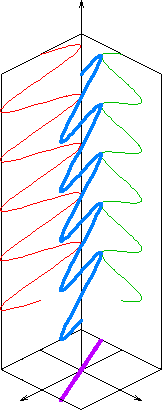In electrodynamics, linear polarization or plane polarization of electromagnetic radiation is a confinement of the electric field vector or magnetic field vector to a given plane along the direction of propagation. See polarization for more information.

Historically, the orientation of a polarized electromagnetic wave has been defined in the optical regime by the orientation of the electric vector, and in the radio regime, by the orientation of the magnetic vector.
Mathematical description of linear polarization
The classical sinusoidal plane wave solution of the electromagnetic wave equation for the electric and magnetic fields is (cgs units)
for the magnetic field, where k is the wavenumber,
is the angular frequency of the wave, and is the speed of light.
Here
is the amplitude of the field and
is the Jones vector in the x-y plane.
The wave is linearly polarized when the phase angles are equal,
- .
This represents a wave polarized at an angle with respect to the x axis. In that case the Jones vector can be written
- .
The state vectors for linear polarization in x or y are special cases of this state vector.
If unit vectors are defined such that
and
then the polarization state can written in the "x-y basis" as
- .
References
- Jackson, John D. (1998). Classical Electrodynamics (3rd ed.). Wiley. ISBN 0-471-30932-X.
See also
- Sinusoidal plane-wave solutions of the electromagnetic wave equation
- Polarization
- Photon polarization
This article incorporates public ___domain material from Federal Standard 1037C. General Services Administration. Archived from the original on 2022-01-22.